Modeling the Spatial Formation Mechanism of Poverty-Stricken Counties in China by Using Geographical Detector
Abstract
1. Introduction
2. Materials and Methods
2.1. Materials
2.2. Calculation of Spatial Influential Factors
2.3. Geographical Detector Model
3. Results
3.1. Spatial Distribution of Influential Factors
3.1.1. Terrain Relief
3.1.2. Cultivated Land Quality
3.1.3. Water Resource Abundance
3.1.4. Road Network Density
3.1.5. Location Index
3.2. Geographical Detection Results of Spatial Influential Factors
4. Discussion
4.1. Spatial Formation Types of Poverty-Stricken Counties
4.1.1. Terrain Condition Constraint
4.1.2. Cultivated Land Resource Constraint
4.1.3. Water Abundance Constraint
4.1.4. Traffic Condition Constraint
4.1.5. Location Condition Constraint
4.2. Spatial Combinations of the Formation Mechanism in Poverty-Stricken Counties
5. Conclusions
Author Contributions
Funding
Acknowledgments
Conflicts of Interest
References
- Liu, Y.; Wang, Y. Rural land engineering and poverty alleviation: Lessons from typical regions in China. J. Geogr. Sci. 2019, 29, 643–657. [Google Scholar] [CrossRef]
- Liao, F.H.F.; Wei, Y.D. Dynamics, space, and regional inequality in provincial China: A case study of Guangdong province. Appl. Geogr. 2012, 35, 71–83. [Google Scholar] [CrossRef]
- Xu, Y.; Qiu, X.; Yang, X.; Chen, G. Factor Decomposition of the changes in the rural regional income inequality in Southwestern mountainous area of China. Sustainability 2018, 10, 3171. [Google Scholar] [CrossRef]
- Zhou, L.; Xiong, L. Natural topographic controls on the spatial distribution of poverty-stricken counties in China. Appl. Geogr. 2018, 90, 282–292. [Google Scholar] [CrossRef]
- Liu, Y.; Liu, J.; Zhou, Y. Spatio-temporal patterns of rural poverty in China and targeted poverty alleviation strategies. J. Rural Stud. 2017, 52, 66–75. [Google Scholar] [CrossRef]
- Rupasingha, A.; Goetz, S.J. Social and political forces as determinants of poverty: A spatial analysis. J. Socio-Econ. 2007, 36, 650–671. [Google Scholar] [CrossRef]
- Chen, X.; Pei, Z.; Chen, A.L.; Wang, F.; Shen, K.; Zhou, Q.; Sun, L. Spatial distribution patterns and influencing factors of poverty—A case study on key country from national contiguous special poverty-stricken areas in China. Procedia Environ. Sci. 2015, 26, 82–90. [Google Scholar] [CrossRef]
- Lü, X. Intergovernmental transfers and local education provision—Evaluating China’s 8-7 National Plan for Poverty Reduction. China Econ. Rev. 2015, 33, 200–211. [Google Scholar] [CrossRef]
- Yang, Z. Threshold effect of poverty alleviation funds on human capital accumulation: A case study of impoverished counties in China. Sustainability 2019, 11, 809. [Google Scholar] [CrossRef]
- Liu, W.; Xu, J.; Li, J. The influence of poverty alleviation resettlement on rural household livelihood vulnerability in the Western mountainous areas, China. Sustainability 2018, 10, 2793. [Google Scholar] [CrossRef]
- Wang, S. Overcoming poverty through development—A review and assessment of the experiences of large scale poverty reduction in China over the past three decades. China Econ. 2009, 3, 104–118. [Google Scholar]
- Cheng, S.; Ding, X. The essence of poverty and development of the poor regions. J. Nat. Resour. 1996, 2, 29–34. [Google Scholar]
- Zhang, H.; Cai, Y.; Zhao, X. Environmental rehabilitation—Fundamental way for sustainable development in poor areas of China. Resour. Sci. 1999, 3, 65–69. [Google Scholar]
- Wei, Z. Analysis of current income distribution in China and its countermeasures. Econ. Perspect. 2010, 8, 55–62. [Google Scholar]
- Chen, N. On the ecological sustainable development of poor mountainous areas. Ecol. Econ. 2000, 11, 25–29. [Google Scholar]
- Wang, X. Analysis of the factors affecting rural poverty in Gansu—An empirical study based on grey correlation. J. Lanzhou Univ. 2012, 40, 137–142. [Google Scholar]
- Zhou, K.; Wang, C. Spatial-temporal pattern of poverty-stricken areas and its differential policies for poverty alleviation in China. Bull. Chin. Acad. Sci. 2016, 31, 101–111. [Google Scholar]
- Wang, Z. The impacts of climate on the society of China during historical times. Acta Geogr. Sin. 1996, 51, 329–339. [Google Scholar]
- Fang, B. Poverty and biodiversity in rural areas based on two investigations in Pujiang County, China. J. Environ. Manag. 2009, 90, 1924–1932. [Google Scholar] [CrossRef]
- Deng, W.; Tang, W. General directions and countermeasures for urbanization development in mountain areas of China. J. Mt. Sci. 2013, 31, 168–173. [Google Scholar]
- Wishitemi, B.E.L.; Momanyi, S.O.; Ombati, B.G.; Okello, M.M. The link between poverty, environment and ecotourism development in areas adjacent to Maasai Mara and Amboseli protected areas, Kenya. Tour. Manag. Perspect. 2015, 16, 306–317. [Google Scholar] [CrossRef]
- Zhang, K.; Dearing, J.A.; Dawson, T.P.; Dong, X.; Yang, X.; Zhang, W. Poverty alleviation strategies in eastern China lead to critical ecological dynamics. Sci. Total Environ. 2015, 506–507, 164–181. [Google Scholar] [CrossRef] [PubMed]
- Liu, Y.; Xu, Y. A geographic identification of multidimensional poverty in rural China under the framework of sustainable livelihoods analysis. Appl. Geogr. 2016, 73, 62–76. [Google Scholar] [CrossRef]
- Husmann, C. Marginality as a root cause of poverty: Identifying marginality hotspots in Ethiopia. World Dev. 2016, 78, 420–435. [Google Scholar] [CrossRef]
- Bennett, K.J.; Probst, J.C.; Pumkam, C. Obesity among working age adults: The role of county-level persistent poverty in rural disparities. Health Place 2011, 17, 1174–1181. [Google Scholar] [CrossRef] [PubMed]
- Maguire–Jack, K.; Lanier, P.; Johnson-Motoyama, M.; Welch, H.; Dineen, M. Geographic variation in racial disparities in child maltreatment: The influence of county poverty and population density. Child Abus. Negl. 2015, 47, 1–13. [Google Scholar] [CrossRef] [PubMed]
- Gamu, J.; Le Billon, P.; Spiegel, S. Extractive industries and poverty: A review of recent findings and linkage mechanisms. Extr. Ind. Soc. 2015, 2, 162–176. [Google Scholar] [CrossRef]
- Loayza, N.; Rigolini, J. The local impact of mining on poverty and inequality: Evidence from the commodity boom in Peru. World Dev. 2016, 84, 219–234. [Google Scholar] [CrossRef]
- He, S.; Liu, Y.; Wu, F. Poverty concentration and determinants in low-income neighbourhoods and social groups in Chinese large cities. Acta Geogr. Sin. 2010, 65, 1464–1475. [Google Scholar]
- Liu, C.; Zeng, J. The calculating method about the comprehensive transport accessibility and its correlation with economic development at county level: The statistical analysis of 79 counties in Hubei Province. Geogr. Res. 2011, 30, 2209–2221. [Google Scholar]
- Rogers, S. Betting on the strong: Local government resource allocation in China’s poverty counties. J. Rural Stud. 2014, 36, 197–206. [Google Scholar] [CrossRef]
- Ellen, I.G.; Horn, K.M.; O’Regan, K.M. Poverty concentration and the low income housing tax credit: Effects of siting and tenant composition. J. Hous. Econ. 2016, 34, 49–59. [Google Scholar] [CrossRef]
- Wang, L.; Huang, X.; Cao, X. The accessibility of different scales and its impacts on economy development in poverty-stricken mountainous areas: A case study in Qinba mountain areas. Econ. Geogr. 2016, 36, 156–164. [Google Scholar]
- Xu, Y.; Li, S.; Cai, Y. Spatial simulation using GIS and artificial neural network for regional poverty—A case study of Maotiaohe water shed, Guizhou Province. Prog. Geogr. 2006, 25, 79–85. [Google Scholar]
- Liu, Y.; Li, J. Geographic detection and optimizing decision of the differentiation mechanism of rural poverty in China. Acta Geogr. Sin. 2017, 72, 161–173. [Google Scholar]
- Wang, J.; Xu, C. Geodetector: Principle and Prospective. Acta Geographica Sinica 2017, 72, 116–134. [Google Scholar]
- National Bureau of Statistics of China (NBSC). Chinese Statistical Yearbook 2017; Statistics Press: Beijing, China, 2017.
- Farr, T.G.; Rosen, P.A.; Caro, E.; Crippen, R.; Duren, R.; Hensley, S.; Kobrick, M.; Paller, M.; Rodriguez, E.; Roth, L.; et al. The shuttle radar topography mission. Rev. Geophys. 2007, 45, RG2004. [Google Scholar] [CrossRef]
- Lv, G.; Xiong, L.; Chen, M.; Tang, G.; Sheng, Y.; Liu, X.; Song, Z.; Lu, Y.; Yu, Z.; Zhang, K.; et al. Chinese progress in geomorphometry. J. Geogr. Sci. 2017, 27, 1389–1412. [Google Scholar] [CrossRef]
- Wang, Y.; Peng, B.; Xiong, J.; Zhang, H. Study on the spatial pattern and influencing factors of population urbanization of Dongting Lake area. Geogr. Res. 2013, 32, 1912–1922. [Google Scholar]
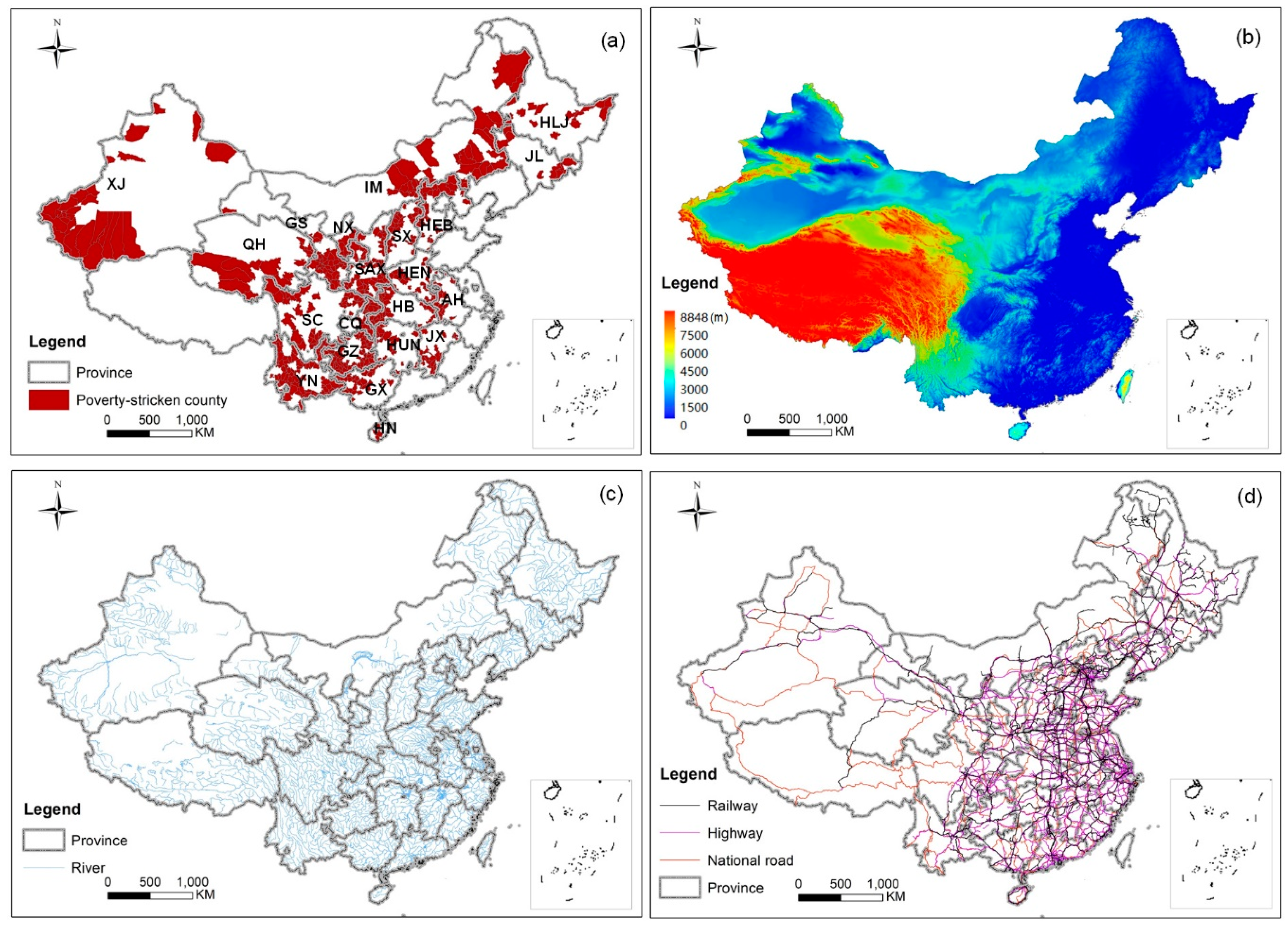
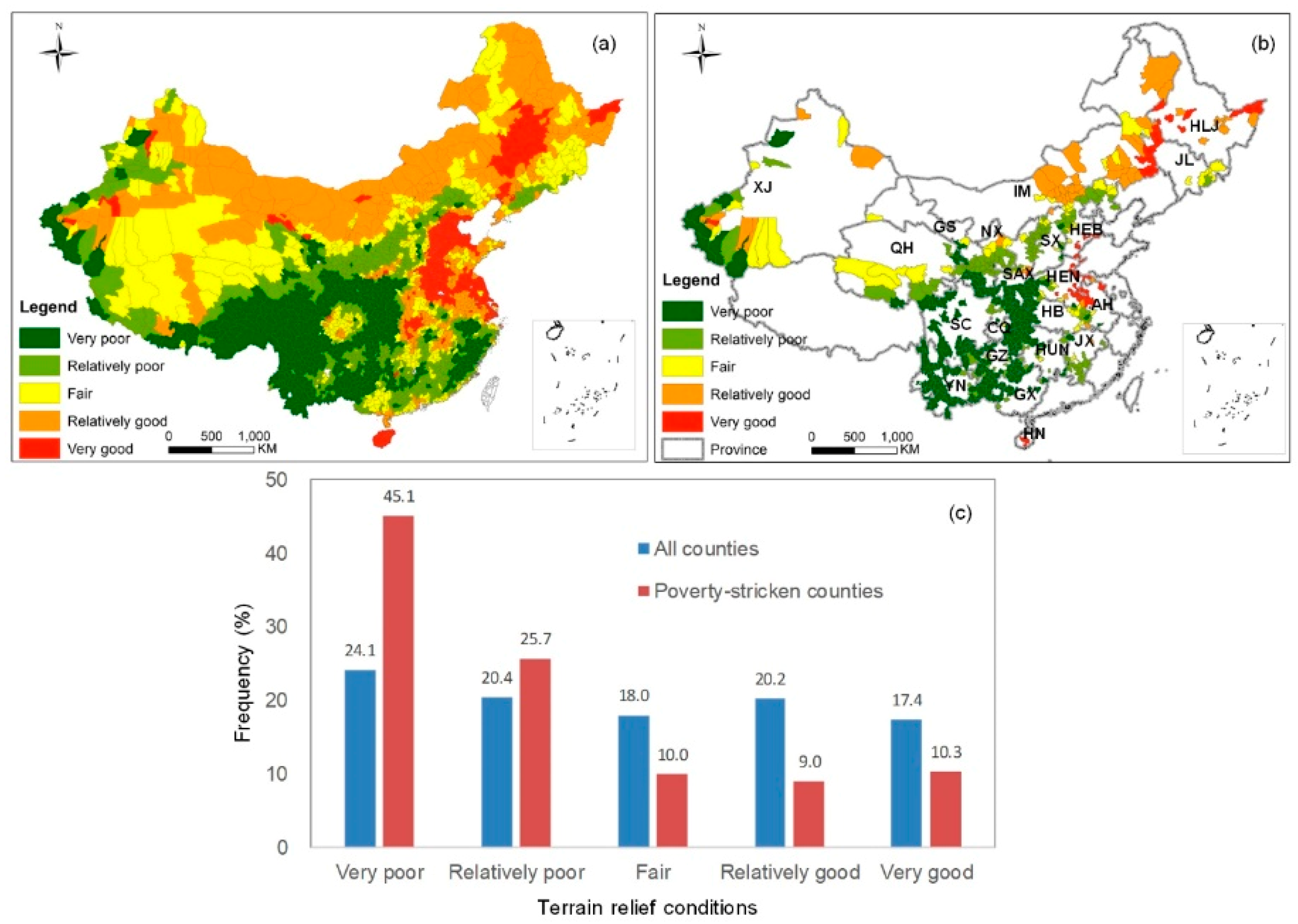
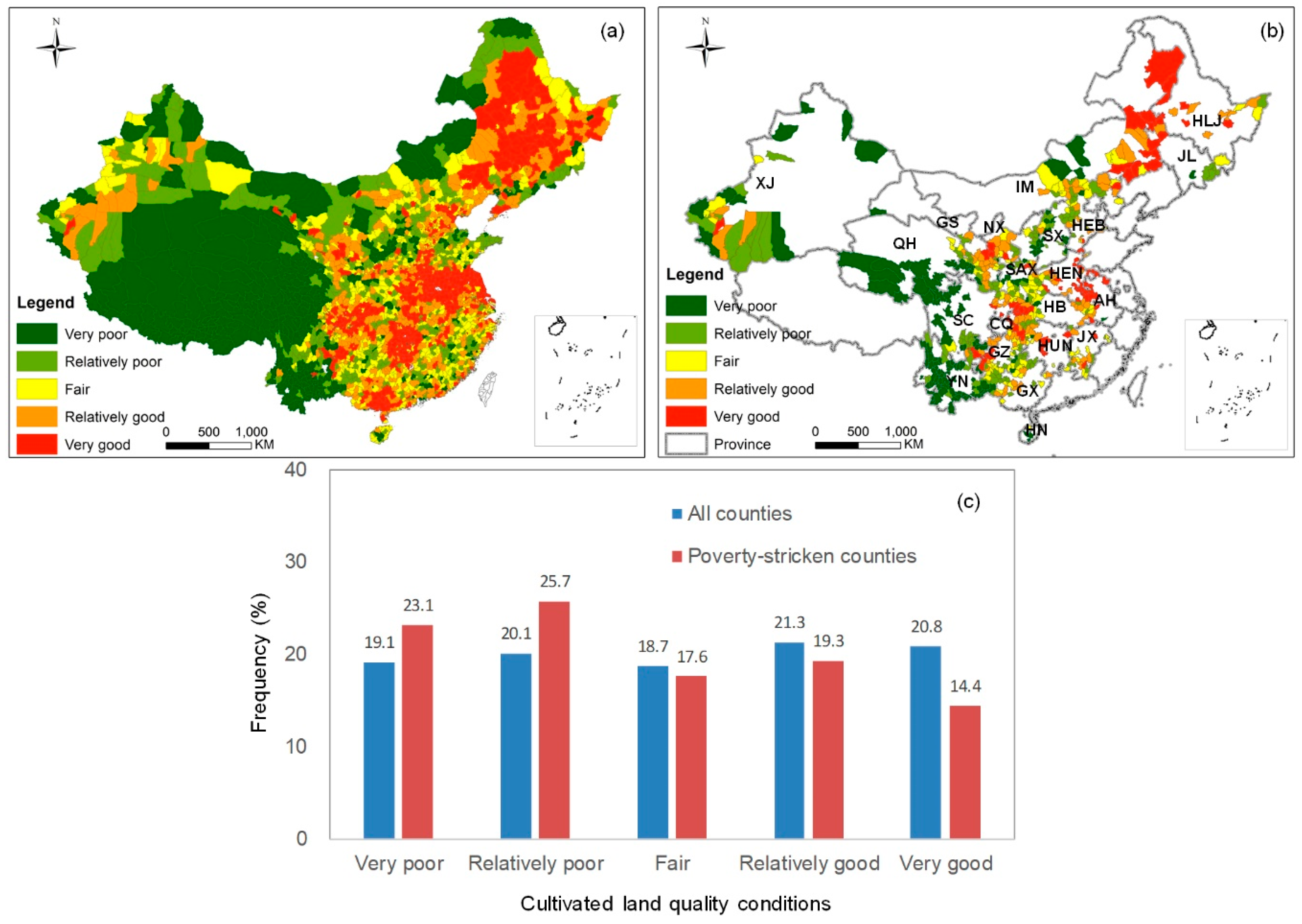
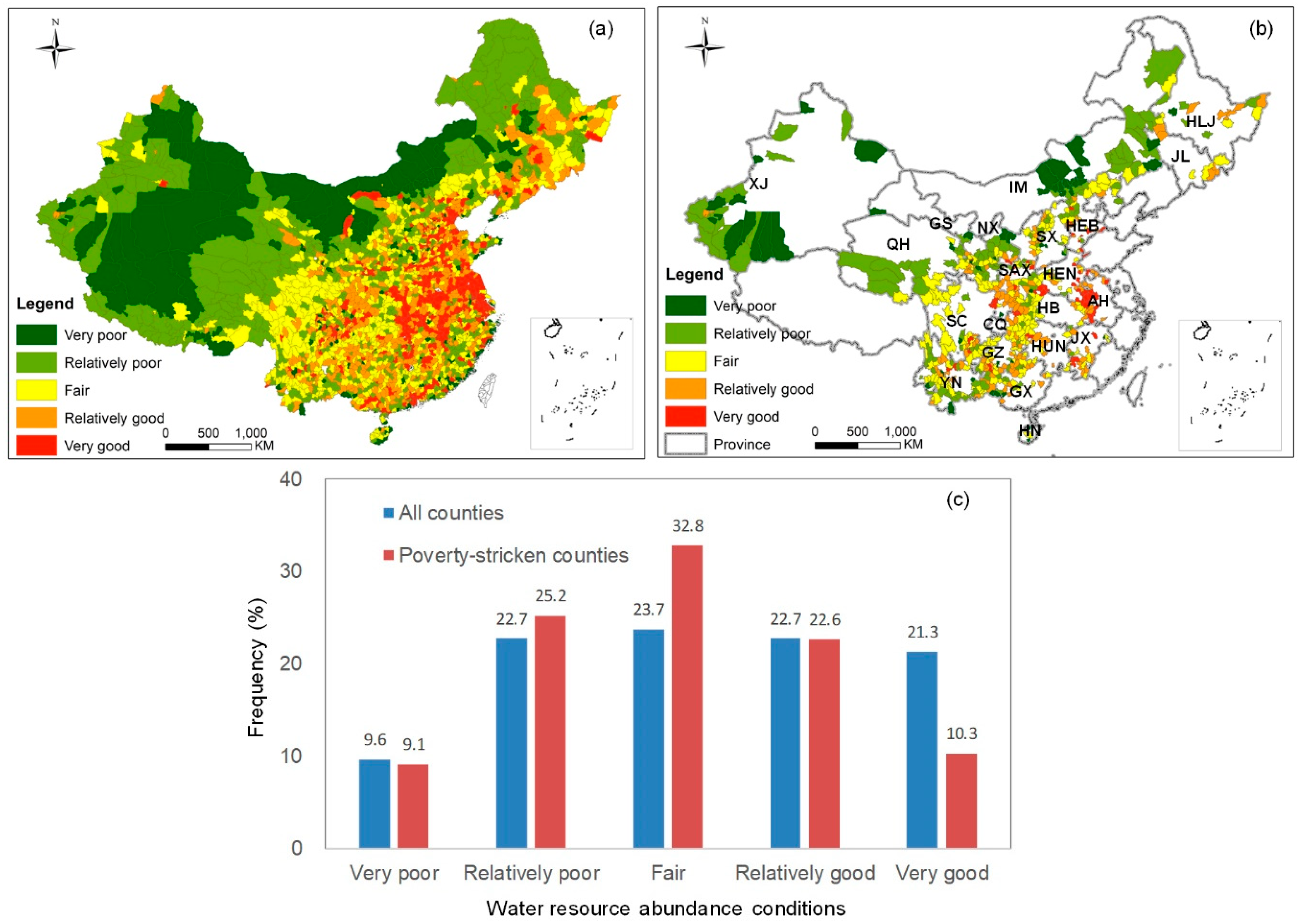
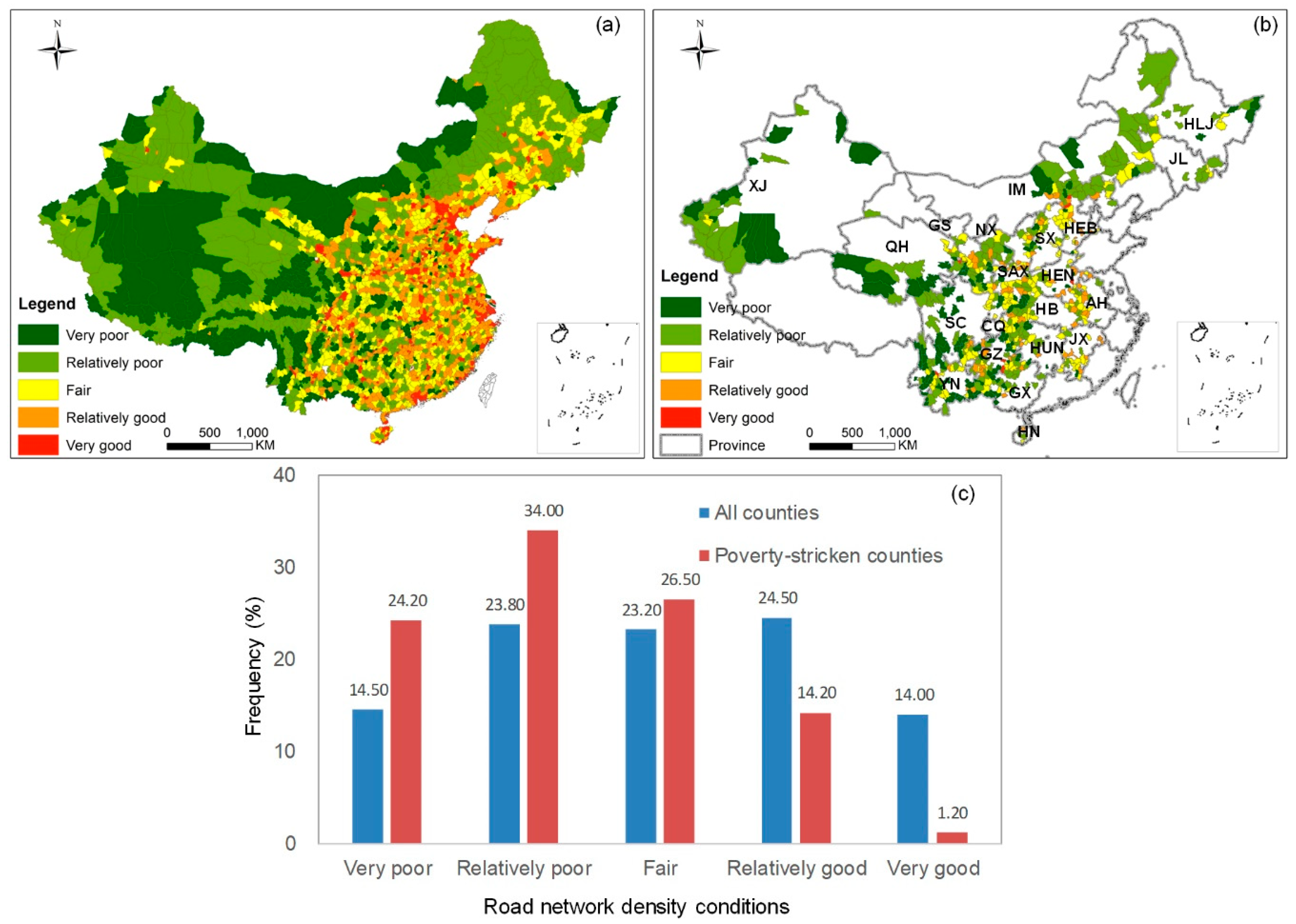

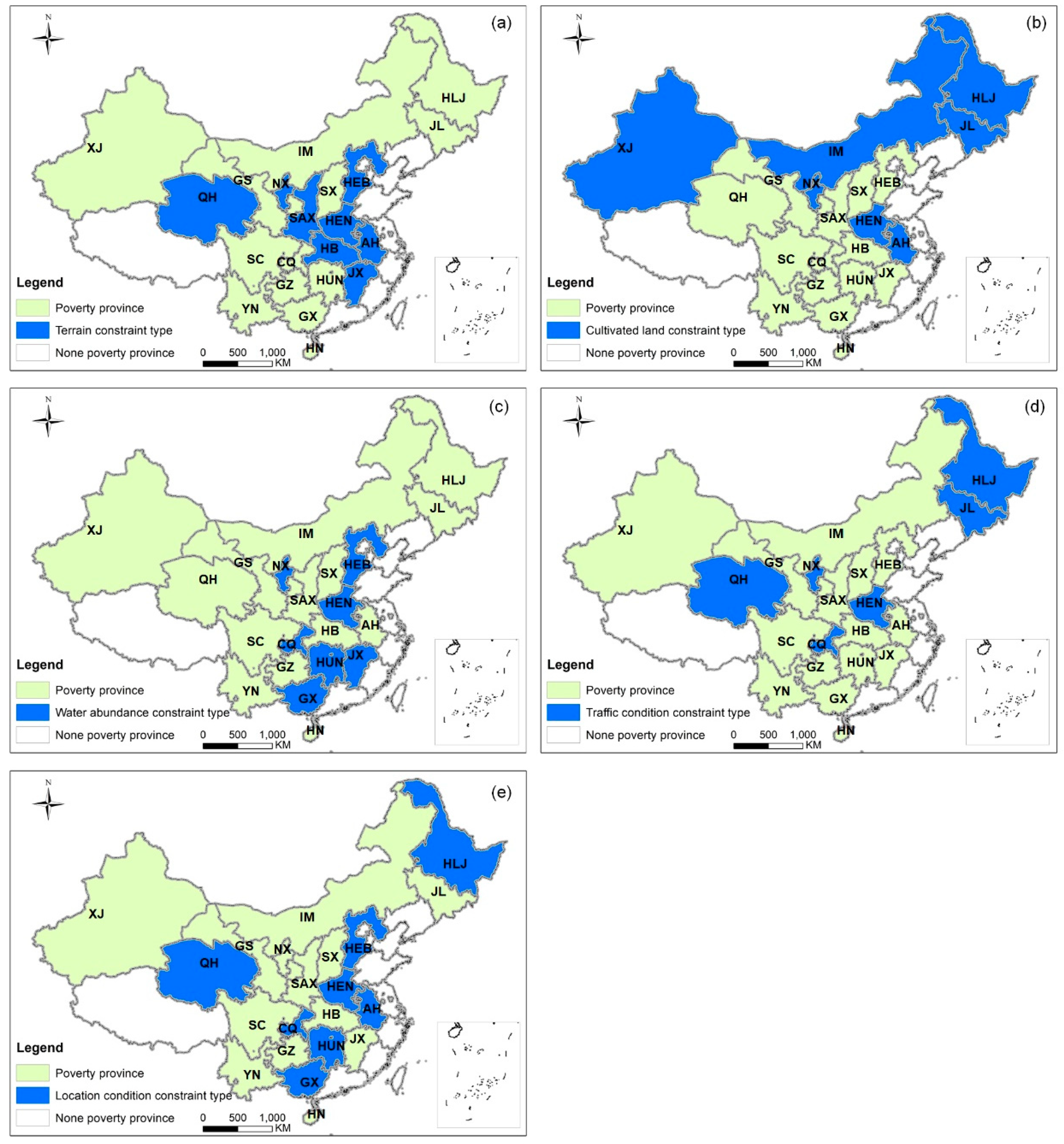
| Region | Province | Abbr. | Per Capita GDP (104 Yuan) | Poverty-Stricken Counties | |
|---|---|---|---|---|---|
| Numbers | Percentage (%) | ||||
| Dongbei Region | Jilin | JL | 5.41 | 8 | 1.35 |
| Heilongjiang | HLJ | 4.04 | 14 | 2.36 | |
| Huabei Region | Inner Mongolia | IM | 7.42 | 31 | 5.24 |
| Hebei | HEB | 4.29 | 39 | 6.59 | |
| Shanxi | SX | 3.53 | 35 | 5.91 | |
| Huanan Region | Hainan | HN | 4.44 | 5 | 0.84 |
| Guangxi | GX | 3.80 | 28 | 4.73 | |
| Huazhong Region | Hubei | HB | 5.52 | 25 | 4.22 |
| Hunan | HUN | 4.61 | 20 | 3.38 | |
| Henan | HEN | 4.24 | 31 | 5.24 | |
| Jiangxi | JX | 4.02 | 21 | 3.55 | |
| Huadong Region | Anhui | AH | 3.93 | 19 | 3.21 |
| Xibei Region | Shaanxi | SAX | 5.05 | 50 | 8.45 |
| Ningxia | NX | 4.72 | 8 | 1.35 | |
| Qinghai | QH | 4.38 | 15 | 2.53 | |
| Xinjiang | XJ | 4.05 | 27 | 4.56 | |
| Gansu | GS | 2.75 | 43 | 7.26 | |
| Xinan Region | Chongqing | CQ | 5.82 | 14 | 2.36 |
| Sichuan | SC | 3.98 | 36 | 6.08 | |
| Guizhou | GZ | 3.32 | 50 | 8.45 | |
| Yunnan | YN | 3.14 | 73 | 12.33 | |
| Total | 592 | 100.00 | |||
| Types | Spatial Constraints | Calculation Formula | Notes of the Formula |
|---|---|---|---|
| Natural factors | Topographic relief (X1) | Hmax and Hmin are the maximum and minimum elevation values. | |
| Cultivated land quality (X2) | P is the county’s population, Pmax and Pmin are the maximum and minimum population of all counties in China, n is the total crop area of the county. | ||
| Water abundance (X3) | Len is the length of water passing through the county, and S is the area of the county. | ||
| Social factors | Road network density (X4) | C1, C2, and C3 are the ratios of the length of national road, highway and railway, and the county area. | |
| Location index (X5) | L is the distance between the county and its provincial capital. e and p are the GDP and population of the county; e0, and p0 are the average values of GDP and population of all counties in the province. |
| Province | Very Poor | Relatively Poor | Fair | Relatively Good | Very Good |
|---|---|---|---|---|---|
| Anhui | 10.5 | 21.1 | 5.3 | 10.5 | 52.6 |
| Gansu | 37.2 | 58.1 | 4.7 | 0.0 | 0.0 |
| Guangxi | 85.7 | 14.3 | 0.0 | 0.0 | 0.0 |
| Guizhou | 82.0 | 18.0 | 0.0 | 0.0 | 0.0 |
| Hainan | 0.0 | 0.0 | 0.0 | 0.0 | 100.0 |
| Hebei | 0.0 | 28.2 | 20.5 | 15.4 | 35.9 |
| Henan | 12.9 | 12.9 | 16.1 | 6.5 | 51.6 |
| Heilongjiang | 0.0 | 0.0 | 0.0 | 42.9 | 57.1 |
| Hubei | 64.0 | 16.0 | 20.0 | 0.0 | 0.0 |
| Hunan | 55.0 | 40.0 | 5.0 | 0.0 | 0.0 |
| Jilin | 0.0 | 12.5 | 50.0 | 0.0 | 37.5 |
| Jiangxi | 9.5 | 81.0 | 4.8 | 4.8 | 0.0 |
| Xinjiang | 25.9 | 14.8 | 25.9 | 25.9 | 7.4 |
| Ningxia | 12.5 | 50.0 | 25.0 | 12.5 | 0.0 |
| Qinghai | 33.3 | 40.0 | 26.7 | 0.0 | 0.0 |
| Shanxi | 8.6 | 68.6 | 20.0 | 2.9 | 0.0 |
| Shaanxi | 48.0 | 32.0 | 8.0 | 10.0 | 2.0 |
| Sichuan | 83.3 | 16.7 | 0.0 | 0.0 | 0.0 |
| Inner Mongolia | 0.0 | 0.0 | 22.6 | 71.0 | 6.5 |
| Yunnan | 93.2 | 6.8 | 0.0 | 0.0 | 0.0 |
| Chongqing | 92.9 | 0.0 | 7.1 | 0.0 | 0.0 |
| National | 45.1 | 25.7 | 10.0 | 9.0 | 10.3 |
| Province | Very Poor | Relatively Poor | Fair | Relatively Good | Very Good |
|---|---|---|---|---|---|
| Anhui | 5.3 | 0.0 | 10.5 | 15.8 | 68.4 |
| Gansu | 14.0 | 30.2 | 14.0 | 37.2 | 4.7 |
| Guangxi | 0.0 | 39.3 | 32.1 | 28.6 | 0.0 |
| Guizhou | 8.0 | 30.0 | 32.0 | 18.0 | 12.0 |
| Hainan | 60.0 | 20.0 | 20.0 | 0.0 | 0.0 |
| Hebei | 2.6 | 25.6 | 28.2 | 35.9 | 7.7 |
| Henan | 0.0 | 6.5 | 6.5 | 29.0 | 58.1 |
| Heilongjiang | 0.0 | 7.1 | 14.3 | 42.9 | 35.7 |
| Hubei | 4.0 | 36.0 | 32.0 | 28.0 | 0.0 |
| Hunan | 5.0 | 20.0 | 25.0 | 25.0 | 25.0 |
| Jilin | 12.5 | 37.5 | 12.5 | 12.5 | 25.0 |
| Jiangxi | 0.0 | 33.3 | 33.3 | 23.8 | 9.5 |
| Xinjiang | 33.3 | 33.3 | 14.8 | 14.8 | 3.7 |
| Ningxia | 12.5 | 12.5 | 25.0 | 25.0 | 25.0 |
| Qinghai | 53.3 | 20.0 | 20.0 | 6.7 | 0.0 |
| Shanxi | 40.0 | 48.6 | 8.6 | 2.9 | 0.0 |
| Shaanxi | 24.0 | 44.0 | 20.0 | 8.0 | 4.0 |
| Sichuan | 36.1 | 27.8 | 8.3 | 19.4 | 8.3 |
| Inner Mongolia | 22.7 | 19.8 | 19.0 | 12.6 | 25.9 |
| Yunnan | 80.8 | 16.4 | 0.0 | 1.4 | 1.4 |
| Chongqing | 0.0 | 0.0 | 0.0 | 28.6 | 71.4 |
| National | 23.1 | 25.7 | 17.6 | 19.3 | 14.4 |
| Province | Very Poor | Relatively Poor | Fair | Relatively Good | Very Good |
|---|---|---|---|---|---|
| Anhui | 0.0 | 0.0 | 0.0 | 47.4 | 52.6 |
| Gansu | 9.3 | 41.9 | 32.6 | 11.6 | 4.7 |
| Guangxi | 10.7 | 25.0 | 28.6 | 35.7 | 0.0 |
| Guizhou | 4.0 | 10.0 | 40.0 | 42.0 | 4.0 |
| Hainan | 40.0 | 20.0 | 40.0 | 0.0 | 0.0 |
| Hebei | 5.1 | 25.6 | 28.2 | 15.4 | 25.6 |
| Henan | 0.0 | 9.7 | 29.0 | 19.4 | 41.9 |
| Heilongjiang | 7.1 | 35.7 | 21.4 | 35.7 | 0.0 |
| Hubei | 0.0 | 24.0 | 52.0 | 16.0 | 8.0 |
| Hunan | 0.0 | 0.0 | 55.0 | 35.0 | 10.0 |
| Jilin | 12.5 | 0.0 | 37.5 | 50.0 | 0.0 |
| Jiangxi | 4.8 | 4.8 | 23.8 | 42.9 | 23.8 |
| Xinjiang | 44.4 | 51.9 | 0.0 | 3.7 | 0.0 |
| Ningxia | 25.0 | 50.0 | 25.0 | 0.0 | 0.0 |
| Qinghai | 6.7 | 60.0 | 33.3 | 0.0 | 0.0 |
| Shanxi | 8.6 | 34.3 | 42.9 | 11.4 | 2.9 |
| Shaanxi | 4.0 | 20.0 | 34.0 | 30.0 | 12.0 |
| Sichuan | 5.6 | 13.9 | 47.2 | 22.2 | 11.1 |
| Inner Mongolia | 38.7 | 48.4 | 12.9 | 0.0 | 0.0 |
| Yunnan | 5.5 | 31.5 | 39.7 | 19.2 | 4.1 |
| Chongqing | 0.0 | 7.1 | 42.9 | 42.9 | 7.1 |
| National | 9.1 | 25.2 | 32.8 | 22.6 | 10.3 |
| Province | Very Poor | Relatively Poor | Fair | Relatively Good | Very Good |
|---|---|---|---|---|---|
| Anhui | 0.0 | 31.6 | 36.8 | 31.6 | 0.0 |
| Gansu | 27.9 | 37.2 | 20.9 | 11.6 | 2.3 |
| Guangxi | 35.7 | 46.4 | 10.7 | 7.1 | 0.0 |
| Guizhou | 30.0 | 28.0 | 22.0 | 16.0 | 4.0 |
| Hainan | 0.0 | 40.0 | 20.0 | 40.0 | 0.0 |
| Hebei | 10.3 | 25.6 | 33.3 | 25.6 | 5.1 |
| Henan | 9.7 | 22.6 | 35.5 | 29.0 | 3.2 |
| Heilongjiang | 28.6 | 50.0 | 21.4 | 0.0 | 0.0 |
| Hubei | 16.0 | 40.0 | 32.0 | 12.0 | 0.0 |
| Hunan | 15.0 | 40.0 | 30.0 | 15.0 | 0.0 |
| Jilin | 0.0 | 75.0 | 25.0 | 0.0 | 0.0 |
| Jiangxi | 4.8 | 19.0 | 47.6 | 28.6 | 0.0 |
| Xinjiang | 48.1 | 44.4 | 7.4 | 0.0 | 0.0 |
| Ningxia | 0.0 | 75.0 | 12.5 | 12.5 | 0.0 |
| Qinghai | 40.0 | 33.3 | 20.0 | 6.7 | 0.0 |
| Shanxi | 14.3 | 31.4 | 42.9 | 11.4 | 0.0 |
| Shaanxi | 10.0 | 20.0 | 38.0 | 32.0 | 0.0 |
| Sichuan | 44.4 | 33.3 | 19.4 | 2.8 | 0.0 |
| Inner Mongolia | 16.1 | 61.3 | 16.1 | 6.5 | 0.0 |
| Yunnan | 47.9 | 24.7 | 20.5 | 5.5 | 1.4 |
| Chongqing | 14.3 | 35.7 | 42.9 | 7.1 | 0.0 |
| National | 24.2 | 34.0 | 26.5 | 14.2 | 1.2 |
| Province | Very Poor | Relatively Poor | Fair | Relatively Good | Very Good |
|---|---|---|---|---|---|
| Anhui | 0.0 | 21.1 | 15.8 | 31.6 | 31.6 |
| Gansu | 0.0 | 11.6 | 37.2 | 32.6 | 18.6 |
| Guangxi | 0.0 | 17.9 | 75.0 | 3.6 | 3.6 |
| Guizhou | 60.0 | 22.0 | 0.0 | 18.0 | 0.0 |
| Hainan | 0.0 | 20.0 | 40.0 | 0.0 | 40.0 |
| Hebei | 12.8 | 20.5 | 43.6 | 12.8 | 10.3 |
| Henan | 0.0 | 3.2 | 19.4 | 41.9 | 35.5 |
| Heilongjiang | 14.3 | 35.7 | 7.1 | 21.4 | 21.4 |
| Hubei | 92.0 | 4.0 | 4.0 | 0.0 | 0.0 |
| Hunan | 15.0 | 30.0 | 40.0 | 10.0 | 5.0 |
| Jilin | 62.5 | 37.5 | 0.0 | 0.0 | 0.0 |
| Jiangxi | 0.0 | 4.8 | 38.1 | 57.1 | 0.0 |
| Xinjiang | 48.1 | 51.9 | 0.0 | 0.0 | 0.0 |
| Ningxia | 12.5 | 62.5 | 25.0 | 0.0 | 0.0 |
| Qinghai | 26.7 | 26.7 | 33.3 | 0.0 | 13.3 |
| Shanxi | 0.0 | 8.6 | 48.6 | 25.7 | 17.1 |
| Shaanxi | 16.0 | 32.0 | 20.0 | 18.0 | 14.0 |
| Sichuan | 83.3 | 16.7 | 0.0 | 0.0 | 0.0 |
| Inner Mongolia | 32.3 | 25.8 | 38.7 | 3.2 | 0.0 |
| Yunnan | 67.1 | 28.8 | 1.4 | 0.0 | 2.7 |
| Chongqing | 14.3 | 21.4 | 42.9 | 14.3 | 7.1 |
| National | 31.3 | 22.1 | 23.0 | 14.5 | 9.1 |
| Province | Terrain Relief | Cultivated Land Quality | Water Abundance | Road Network Density | Location Index |
|---|---|---|---|---|---|
| Hebei | 0.294 | 0.208 | 0.226 | 0.057 | 0.416 |
| Shanxi | 0.117 | 0.055 | 0.107 | 0.079 | 0.162 |
| Jilin | 0.120 | 0.835 | 0.017 | 0.204 | 0.085 |
| Heilongjiang | 0.023 | 0.636 | 0.067 | 0.242 | 0.482 |
| Anhui | 0.519 | 0.602 | 0.011 | 0.155 | 0.326 |
| Jiangxi | 0.257 | 0.144 | 0.393 | 0.192 | 0.043 |
| Henan | 0.363 | 0.496 | 0.252 | 0.198 | 0.325 |
| Hubei | 0.181 | 0.225 | 0.062 | 0.031 | 0.014 |
| Hunan | 0.099 | 0.057 | 0.254 | 0.103 | 0.222 |
| Chongqing | 0.001 | 0.053 | 0.643 | 0.735 | 0.647 |
| Sichuan | 0.009 | 0.224 | 0.095 | 0.188 | 0.001 |
| Guizhou | 0.000 | 0.105 | 0.027 | 0.148 | 0.087 |
| Yunnan | 0.056 | 0.092 | 0.044 | 0.061 | 0.026 |
| Shaanxi | 0.198 | 0.093 | 0.058 | 0.100 | 0.070 |
| Gansu | 0.020 | 0.051 | 0.067 | 0.023 | 0.061 |
| Qinghai | 0.153 | 0.020 | 0.061 | 0.236 | 0.290 |
| Inner Mongolia | 0.015 | 0.569 | 0.145 | 0.154 | 0.072 |
| Ningxia | 0.313 | 0.455 | 0.465 | 0.970 | 0.176 |
| Guangxi | 0.091 | 0.024 | 0.190 | 0.007 | 0.255 |
| Xinjiang | 0.079 | 0.461 | 0.022 | 0.068 | 0.143 |
| Mean | 0.145 | 0.270 | 0.161 | 0.198 | 0.195 |
| Cluster Type | Province | Spatial Constraint |
|---|---|---|
| Single factor | Hubei | Terrain relief 0.181 |
| Shaanxi | Terrain relief 0.198 | |
| Inner Mongolia | Cultivated land quality 0.569 | |
| Xinjiang | Cultivated land quality 0.461 | |
| Double factors | Jiangxi | Terrain relief 0.257, Water abundance 0.393 |
| Jilin | Cultivated land quality 0.835, Road network density 0.204 | |
| Hunan | Water abundance 0.254, Location index 0.222 | |
| Guangxi | Water abundance 0.190, Location index 0.255 | |
| Multiple factors | Hebei | Terrain relief 0.294, Water abundance 0.226, Location index 0.416 |
| Heilongjiang | Cultivated land quality 0.636, Road network density 0.242, Location index 0.482 | |
| Anhui | Terrain relief 0.519, Cultivated land quality 0.602, Location index 0.326 | |
| Chongqing | Water abundance 0.643, Road network density 0.735, Location index 0.647 | |
| Henan | Terrain relief 0.363, Cultivated land quality 0.496, Water abundance 0.252, Road network density 0.198, Location index 0.325 | |
| Qinghai | Terrain relief 0.153, Road network density 0.236, Location index 0.290 | |
| Ningxia | Terrain relief 0.313, Cultivated land quality 0.455, Water abundance 0.465, Road network density 0.970 |
© 2019 by the authors. Licensee MDPI, Basel, Switzerland. This article is an open access article distributed under the terms and conditions of the Creative Commons Attribution (CC BY) license (http://creativecommons.org/licenses/by/4.0/).
Share and Cite
Zhou, L.; Zhen, F.; Wang, Y.; Xiong, L. Modeling the Spatial Formation Mechanism of Poverty-Stricken Counties in China by Using Geographical Detector. Sustainability 2019, 11, 4752. https://doi.org/10.3390/su11174752
Zhou L, Zhen F, Wang Y, Xiong L. Modeling the Spatial Formation Mechanism of Poverty-Stricken Counties in China by Using Geographical Detector. Sustainability. 2019; 11(17):4752. https://doi.org/10.3390/su11174752
Chicago/Turabian StyleZhou, Lei, Feng Zhen, Yiqing Wang, and Liyang Xiong. 2019. "Modeling the Spatial Formation Mechanism of Poverty-Stricken Counties in China by Using Geographical Detector" Sustainability 11, no. 17: 4752. https://doi.org/10.3390/su11174752
APA StyleZhou, L., Zhen, F., Wang, Y., & Xiong, L. (2019). Modeling the Spatial Formation Mechanism of Poverty-Stricken Counties in China by Using Geographical Detector. Sustainability, 11(17), 4752. https://doi.org/10.3390/su11174752






